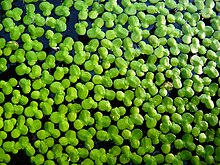Lemna
| Lemna | |
|---|---|

| |
| Common duckweed (Lemna minor) | |
| Scientific classification | |
| Kingdom: | Plantae |
| Clade: | Tracheophytes |
| Clade: | Angiosperms |
| Clade: | Monocots |
| Order: | Alismatales |
| Family: | Araceae |
| Subfamily: | Lemnoideae |
| Genus: | Lemna L. |
| Synonyms[1][2] | |
| |
Lemna is a genus of free-floating aquatic plants referred to by the common name "duckweed". They are morphologically divergent members of the arum family Araceae. These rapidly growing plants have found uses as a model system for studies in community ecology, basic plant biology, ecotoxicology, and production of biopharmaceuticals, and as a source of animal feeds for agriculture and aquaculture. Currently, 14 species of Lemna are recognised.[3]
Taxonomy
These duckweeds were previously placed in a separate flowering plant family, the
Description
Lemna species grow as simple free-floating
The plants grow mainly by vegetative reproduction: two daughter plants bud off from the adult plant. This form of growth allows very rapid colonisation of new water. Duckweeds are flowering plants, and nearly all of them are known to reproduce sexually, flowering and producing seed under appropriate conditions. Certain duckweeds (such as L. gibba) are long-day plants, while others (such as L. minor) are short-day plants.
When Lemna invades a waterway, it can be removed mechanically, by the addition of herbivorous fish (e.g. grass carp), or, inadvisedly, treated with a herbicide.
The rapid growth of duckweeds finds application in bioremediation of polluted waters, in municipal wastewater treatment [5] and as test organisms for environmental studies.[6] It is also being used as an expression system for economical production of complex biopharmaceuticals.
Duckweed meal (dried duckweed) is a good cattle feed. It contains 25–45% protein (depending on the growth conditions), 4.4% fat, and 8–10% fibre, measured by dry weight.
As a bioassay
Production of biopharmaceuticals
Lemna has been transformed by
Duckweed farming
High yields of duckweed with a high protein content for use in

Duckweed can be farmed organically, with nutrients being supplied from a variety of sources, for example human urine,[12] cattle manure, pig waste, biogas plant slurry, or other organic matter in slurry form. Because of the rapid growth of duckweed, daily harvesting is necessary to achieve optimal yields. Harvesting is done such that less than 1 kg/m2 of duckweed remains. Under optimal conditions, a duckweed farm can produce 10 to 30 tons of dried duckweed per hectare per year.[13]
Species
Infrageneric classification following Les et al. 2002.[14]
- Section Alatae
- Lemna aequinoctialis Welw. – lesser duckweed – tropical and subtropical
- Lemna perpusilla Torr. – minute duckweed – eastern United States, Quebec
- Section Biformes
- Lemna tenera Kurz – Indochina, Sumatra, Northern Territory of Australia
- Section Lemna
- Lemna disperma Hegelm.
- Lemna ecuadoriensisLandolt
- Lemna gibba L. – gibbous duckweed – widespread
- Lemna japonica Landolt – Japan, China, Korea, Russian Far East
- Lemna minor L. – common duckweed – cosmopolitan
- Lemna obscura (Austin) Daubs – United States, Mexico, Bahamas, Colombia, Ecuador
- Lemna trisulca L. – ivy duckweed – cosmopolitan
- Lemna turionifera Landolt – temperate Europe, Asia, North America
- Section Uninerves
- Lemna minuta Kunth – least duckweed – North + South America
- Lemna valdiviana Phil. – Valdivia duckweed – North and South America
- Lemna yungensis Landolt – Bolivia
- Formerly placed here
- Landoltia punctata(G.Mey.) Les & D.J.Crawford (as L. oligorrhiza Kurz and L. punctata G.Mey.)
- Spirodela polyrhiza (L.) Schleid. (as L. polyrhiza L.)
- Wolffia arrhiza (L.) Horkel ex Wimm. (as L. arrhiza L.)
- Wolffia globosa (Roxb.) Hartog & Plas (as L. globosa Roxb.)[15]
References
- ^ Kew World Checklist of Selected Plant Families
- ^ "Genus: Lemna L." Germplasm Resources Information Network. United States Department of Agriculture. 2006-11-03. Archived from the original on 2015-09-24. Retrieved 2013-04-13.
- ^ "Search results — the Plant List".
- .
- S2CID 3805774.
- ^ Gatidou et al., 2015. Assessing single and joint toxicity of three phenylurea herbicides using Lemna minor and Vibrio fischeri bioassays. Chemosphere vol. 119, January 2015, p. 569-574. Gatidou et al., 2015
- ^ SourceOECD: issues
- ^ "Archived copy" (PDF). Archived from the original (PDF) on 2008-12-17. Retrieved 2007-03-09.
{{cite web}}: CS1 maint: archived copy as title (link) - ^ "Biolex Corporate Website".
- .
- S2CID 1840557.
- ^ "From urine to protein".
- ^ Leng, R A; J H Stambolie; R Bell (October 1995). "Duckweed – a potential high-protein feed resource for domestic animals and fish". Livestock Research for Rural Development. 7 (1). Archived from the original on March 24, 2005.Scholar search
- ^ Les, Donald H.; Crawford, Daniel J.; Landolt, Elias; Gabel, John D.; Kimball, Rebecca T. (2002). "Phylogeny and Systematics of Lemnaceae, the Duckweed Family" (PDF). Systematic Botany. 27 (2): 221–240. Retrieved 2020-04-17.
- ^ "GRIN Species Records of Lemna". Germplasm Resources Information Network. United States Department of Agriculture. Retrieved 2020-04-17.
General readings
- Cross, J.W. (2006). The Charms of Duckweed.
- Landolt, E. (1986) Biosystematic investigations in the family of duckweeds (Lemnaceae). Vol. 2. The family of Lemnaceae – A monographic study. Part 1 of the monograph: Morphology; karyology; ecology; geographic distribution; systematic position; nomenclature; descriptions. Veröff. Geobot. Inst., Stiftung Rübel, ETH, Zurich.
-
Ivy Duckweed (Lemna trisulca)
-
Gibbous Duckweed (Lemna gibba)
-
Common Duckweed (Lemna minor)



